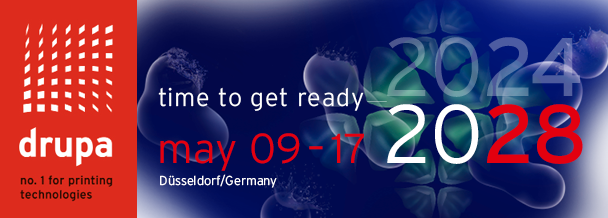AI in the media and printing industry

A guest article by Knud Wassermann (Editor in Chief of Graphische Revue).
Since the end of November 2022, not a day goes by without a new report on the topic of "Artificial Intelligence" (AI) being published. Due to developments in the field of generative AI and the underlying language models, the application of AI is now open to everyone. With "Chat GPT," one can quickly write a text, or with "Midjourney," generate realistic images. What impact will AI have on the media and printing industry? Text by Knud Wassermann.
Quality and process optimization have been a topic in the printing industry for many years, and very often, Artificial Intelligence (AI), or better said "Machine Learning" (ML), is used specifically for individual tasks. Usually, such approaches are classified as weak AI solutions. Through image data acquisition and recognition, for example, quality is controlled across all process steps, and in case of deviation from reference data, software automatically compensates for it. This happens on-the-fly without any manual intervention. This applies equally to analogue and digital printing machines.
A lot has happened in recent years regarding process optimization, and overall equipment effectiveness (OEE) is continually being raised. The acronym OEE represents a business metric that measures the percentage of actual productive manufacturing time. The average value for offset printing machines is currently slightly over 30% according to current numbers from Heidelberg. Individual printers that rely heavily on automation and optimization are already achieving peak values of more than 60% depending on the order mix. By integrating the machines into cloud-based solutions, order sequences, setup times, spoilage rates, process stability, and much more can be improved. But preventive maintenance concepts also help keep machine availability high. This requires big data applications that are continually supplied with new data via the cloud.
AI, a data-driven algorithm
Generative AI is based on a data-driven algorithm. The internet provides an abundance of data, and this happens de facto on-the-fly via e-commerce or social media platforms. Databases operating in the background feed the algorithms very specifically until they have grown into powerful tools over time. Amazon, for example, created an algorithm years ago that predicts what customers will buy next. With the Chatbot "Chat GPT" from OpenAI and image generators such as "Stable Diffusion" or "Midjourney," the world of AI is accessible to everyone without having to program a single line themselves.
Sustainability largely ignored
It is astonishing how quickly the development and market penetration of individual AI solutions has taken place. OpenAI created Chat GPT in 2.5 years, it was launched on 30 November 2022, and within 5 days, 1 million users had registered. Two months later, there were already 100 million. In comparison, Facebook took ten months. A problem with all generative AI solutions is the "data basis" on which AI is built: where does the data come from? With which data are the algorithms fed? How is diversity represented in AI solutions, for example? These are certainly not the only questions that remain unanswered. Where do the copyrights lie - with the company that developed the AI solution or with the user of the AI solution? Data protection issues must also be re-examined as AI applications are largely cloud-based, and the issue of sustainability has largely been ignored to date.
Who takes responsibility?
ChatGPT can certainly be used in professional environments, such as supporting online shop consultation, where chatbots are already in use today. But it can also be used in customer service and marketing, especially in creating product pages and formulating product description texts. By using AI, time-consuming manual tasks in these areas can be optimized. However, the responsibility for verifying and validating the generated information clearly lies with the user - in other words, blind trust in AI should not be placed.
KI und Robotik – ein Dream-Team
Mit »mindjourney« oder »DALL-E«, erhält man, vorausgesetzt man gibt die passenden «Prompts», also Schlagwörter, ein, sehr schnell ein brauchbares Ergebnis. Je detailreicher die Prompts ausfallen, um so besser werden die Bilder. Die Plattform looka.com (www.looka.com) hilft bei der Erstellung von Logos und unterschiedlichsten Corporate Design-Elementen. Das Ganze gibt es natürlich auch für den Video-Bereich und dann sind wir ganz schnell bei dem Thema »Deep Fake«. Der Begriff bringt es ziemlich gut auf den Punkt: es entstehen neue Bilder oder Videosequenzen, die nicht unbedingt etwas mit der Realität zu tun haben müssen.
Content from AI
Adobe recently demonstrated with generative AI models what will be possible in graphic design. "Generative AI is the next evolution of AI-driven creativity and productivity that makes the conversation between creators and computers more natural, intuitive, and powerful," emphasizes David Wadhwani, President of Adobe's Digital Media Business. The company promises that with "Firefly," everyone can transform their own words into creative ideas, regardless of their personal knowledge. The first applications that will benefit from Firefly integration are Express, Experience Manager, Photoshop, and Illustrator.
Adobe wants to address another issue that has not yet been clearly regulated by founding the Content Authenticity Initiative (CAI) to create a global standard for trusted attribution of digital content. Adobe assures that it is committed to open industry standards and wants to use the CAI's free open-source tools. The goal is to embed a universal "tag" in the file information. This would enable image creators to exclude their content from being used to train AI image generators. The tag should be linked to the content wherever it is used, published, or saved. In addition, AI-generated content will be appropriately marked and rewarded.
My Take
In addition to the weak AI solutions described at the beginning, which optimize targeted tasks in the entire production chain within the printing industry, generative AI solutions will significantly change the creative and design industry. New visual worlds, logos, or fonts can be created with just a few "prompts." The market will ultimately decide which requirements can be met. For print service providers, the tools of the Firefly platform could open up possibilities for providing increased graphic design support to customers. More will probably be debated during drupa and this is why you should be there where you will touch the future.
About the author

Knud Wassermann has been Editor in Chief of Graphische Revue since 1998, during which time he has transformed the journal into a leading title for media design and production.
A graduate of the Vienna College of Graphic Design (HGBLVA), he has been a close observer of the industry from a variety of perspectives for more than 35 years. After completing his degree course, Mr. Wassermann spent three years as a member of the Druckspiegel editorial team and subsequently worked as a freelance editor for numerous other journals, including Polygraph, Deutscher Drucker and Viscom. He additionally supports several manufacturers with the design and editing of their customer magazines.
Mr. Wassermann is constantly in touch with the latest developments from his intensive daily contacts with producers and users. He assesses, presents and analytically documents current trends, facts and backgrounds covering all aspects of the printing industry.



